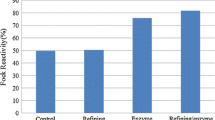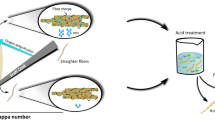Abstract
The effects of heating lab cooked never dried kraft pulp from pine and spruce at 5 % consistency to 80, 100 and 120 °C in a pressurized vessel were evaluated based on various fiber and sheet properties. The settings of pH and conductivity in the lab trial were chosen in accordance with operations such as oxygen delignification, alkaline extraction, washing or storage of pulp in an integrated paper mill. It was found that the tensile strength was reduced steadily with increasing temperature. Nuclear magnetic resonance spectroscopy showed that fiber crystallinity and pore size increased at high temperatures compared to the unheated reference. Crystallinity most likely affected the fiber flexibility and thus resulted in less and weaker fiber–fiber bonds. Atomic force microscopy indicated that the amount of precipitated lignin granules on the fiber surface was reduced with increasing temperature. The roughness of the fiber surface did not significantly change with temperature and hence did not negatively influence the tensile strength. It was remarkable that a so called reversed latency was observed. Instead of a decrease in fiber curl with temperature, the fiber became significantly more curled. A large portion of the losses in tensile strength was attributed to the increase in fiber curl and leaching of hemicelluloses from the fiber wall.
Zusammenfassung
In dieser Studie wurden die Effekte einer Temperaturbehandlung von ungebleichtem und ungemahlenem Kraftzellstoff bei 80 °C, 100 °C und 120 °C auf die Faser- und Papiereigenschaften in einer umfangreichen Laborstudie untersucht. Die Einstellungen von pH-Wert und Leitfähigkeit der 5 %igen Zellstofflösung wurden in Anlehnung an die industriellen Bedingungen in der alkalischen Wäsche, Extraktion oder Sauerstoff-Delignifizierung eingestellt. Es wurde gezeigt, dass die Zugfestigkeit mit zunehmender Temperatur im Laborreaktor signifikant geringer wurde. Nuklear Magnet Resonanz (NMR) Spektroskopie zeigte, dass im Vergleich zur unbehandelten Referenz die Faserkristallinität und der mittlere Porendurchmesser der Faserzellwand mit zunehmender Temperatur anstieg. Höchstwahrscheinlich führte die gestiegene Faserkristallinität zu einer geringeren Fasersteifigkeit, wodurch Anzahl und die Festigkeit der Faser-Faser-Bindungen abnahm. Atom Kraft Mikroskopie (AFM) belegte, dass die Anzahl der Lignin Granulate an der Faseroberfläche mit steigender Temperatur signifikant abnahmen und somit die Festigkeit nicht negativ beeinflusste. Die Rauigkeit der Faseroberfläche wurde nur unwesentlich beeinflusst und hatte somit keine Auswirkungen auf die Zugfestigkeit der Laborblätter. Die Temperaturbehandlung einer 5 %igen Zellstofflösung führte zu einer umgekehrten Faserlatenz, das heißt die Faserkräuselung nahm mit zunehmender Temperatur zu anstatt ab. Die zunehmende Faserkräuselung und der abnehmende Anteil an Hemizellulosen in der Zellwand mit steigender Temperatur hatten ebenfalls einen nicht zu vernachlässigenden negativen Einfluss auf die Festigkeitsverluste.






Similar content being viewed by others
References
Andreasson B, Forsström J, Wagberg L (2003) The porous structure of pulp fibres with different yields and its influence on paper strength. Cellulose 10:111–123
Bar G, Thomann Y, Brandsch R, Cantow HJ, Whangbo MH (1997) Factors affecting the height and phase images in tapping mode atomic force microscopystudy of phase-separated polymer blends of poly(ethene-co-styrene) and polydimethyl-1,4-phenylene oxide). Langmuir 13(14):3807–3812
Binnig G, Quate C, Gerber C (1986) Atomic force microscope. Phys Rev Lett 56(9):930–933
Bjerre AB, Plöger A, Simoneson T, Woidemann A, Schmidt AS (1996) Quantification of solubilized hemicelluloses from pretreated lignocellulose by acid hydrolysis and high performance liquid chromatography. Report Riso R-855 (EN), Riso National Laboratory, Roskilde, Denmark. ISBN: 87-550-8137-2
Carlsson G, Kolseth P, Lindström T (1983) Polyelectrolyte swelling behavior of chlorite delignified spruce wood fibers. Wood Sci Technol 17(1):69–73
Eriksson G, Gren U (1997) Pulp washing: influence of temperature on lignin leaching of kraft pulps. Nord Pulp Pap Res J 12(4):244–251
Favis BD, Willis JM, Goring DAI (1983a) The effect of electrolytes on the leaching of lignin from unbleached kraft pulp fibers. J Wood Chem Techn 3(1):9–16
Favis BD, Willis JM, Goring DAI (1983b) High temperature leaching of lignin from unbleached kraft pulp fibers. J Wood Chem Technol 3(1):1–7
Fung BM, Khitrin AK, Ermolaev K (2000) An improved broadband decoupling sequence for liquid crystals and solids. J Magn Reson 142:97–101
Ganser C (2011) Surface characterization of cellulose fibers by atomic force microscopy in liquid media and under ambient conditions. Diploma thesis, Montanuniversität Leoben, Austria
Htun M, Engstrand P, Salmen L (1988) The implication of lignin softening on latency removal of mechanical and chemimechanical pulps. J Pulp Pap Sci 14(5):J109–J113
ISO Standard (2004a) 5269-2. Pulps—prep of lab sheets for physical testing, Part 2_Rapid-Köthen method
ISO Standard (2004b) 302. Determination of kappa number
ISO Standard (2005) 1924-3. Paper and board—determination of tensile properties, Part 3_Constant rate of elongation method 100 mm/min
Jayme G (1958) Chemical and morphological factors influencing pulp strength properties. Tappi J 41(11):178A–180A
Katz S, Beatson RP, Scallan AM (1984) The determination of strong and weak acidic groups in sulfite pulps. Svensk Papp 6:R48–R53
Larsson PT, Wickholm K, Iversen T (1997) A CP/MAS 13C NMR investigation of molecular ordering in celluloses. Carbohydr Res 302:19–25
Leitner J (2010) Effects of high temperature treatments on various chemical pulp and paper properties—a review. In: Proceedings of the Zukunft Forum Papier—Die österreichische Papierfachtagung, Graz, Austria
Li J, MacLeod JM (1993) Alkaline Leaching of kraft pulps for lignin removal. J Pulp Pap Sci 19(2):J85–J91
Li T, Phoenix A, MacLeod JM (1996) Diffusion of lignin macromolecules within fibre walls of kraft pulp. Part I: Determination of the restricted diffusion coefficient under alkaline conditions. Pulp Washing Conference, pp 139–145
Lindström T (1980) Der Einfluß chemischer Faktoren auf Faserquellung und Papierfestigkeit. Das Papier 34(12):561–568
Luukko K, Maloney TC (1999) Swelling of mechanical pulp fines. Cellulose 6:123–135
Maloney TC, Laine GE, Paulapuro H (1999) Comments of measurement of cell wall water. Tappi J 82(9):125–127
Mishra BP, Bhargava GG, Thusu NK (2003) Alkali leaching of final washed B.S.W. pulp and its effect on bleached pulp quality. Ind Pulp Pap Techn Ass J 15(1):21–27
Mohlin U-B, Salmen L (2005) Which are the important fibre properties? In: SPCI international conference, Stockholm, Sweden, pp 1–5
Mohlin U-B, Dahlblom J, Hornatowska J (1996) Fiber deformation and sheet strength. Tappi J 79(6):105–111
Mohlin U-B, Molin U, Waubert de Puiseau M (2003) Some aspects of using zero-span tensile index as a measure of pulp strength. In: International paper physics conference, Victoria, BC, Canada, Sept. 7–11, pp 107–113
Pikka et al. (2000) Bleaching applications, Chapter 9. In: Gullichsen J, Fogelholm C-J (eds) Papermaking science and technology, Book 6A. ISBN: 952-5216-06-3
Salmen L, Kolseth P, de Ruvo A (1985) Modeling the softening behavior of wood fibers. J Pulp Pap Sci 11(4):J102–J107
Schild G (2011) Personal communication. Lenzing AG, Werksstraße 2, Lenzing, Austria
Sjöberg J, Höglund H (2005) Refining system for sack paper pulp: part 1 HC refining under pressurised conditions and subsequent LC refining. Nord Pulp Pap Res J 20(3):320–328
Sjöberg J, Höglund H (2007) High Consistency refining of kraft pulp reinforced paper based TMP furnishes. In: International mechanical pulping conference, vol. 2 of 2, Minneapolis, Minnesota, USA, May 6–9
Somwang K, Enomae T, Isogai A, Onabe F (2002) Changes in crystallinity and re-swelling capability of pulp fibers by recycling. Jpn Tappi J 56(6):863–869
SCAN Standard (1999) CM 15. Pulps-viscosity in cupriethylenediamine solution
Stockman L, Teder A (1963) The effect of drying on the properties of papermaking pulps: part 2 The effect of heat-treatment on the mechanical properties. Svensk Papp 66(20):822–833
Stone JE, Scallan AM (1967) The effect of component removal upon the porous structure of the cell wall of wood. 2: Swelling in water and the fiber saturation point. Tappi J 50(10):496–501
Suess HU (2000) Pulp bleaching today. Walter de Gruyter Berlin, New York. ISBN: 978-3-11-020737-8
Tschirner U, Barsness J, Keeler T (2007) Recycling of chemical pulp from wheat straw corn stover. BioRess 2(4):536–543
Wathen R (2006) Studies on fiber strength and its effect on paper properties. Dissertation—KCL Communications 11
Welf ES, Benditti RA, Hubbe JJ, Pawlak JJ (2005) The effects of heating without water removal and drying on the swelling measured by water retention value and degradation as measured by intrinsic viscosity of cellulose papermaking fibers. Prog Pap Recycl 14(3):5–13
Zuckerstaetter G, Schild G, Wollboldt P, Roeder T, Weber HK, Sixta H (2009) The elucidation of cellulose supramolecular structure by 13C CP-MAS NMR. Lenzinger Ber 87:38–46
Acknowledgments
The financial support by the Austrian Federal Ministry of Economy, Family and Youth and the National Foundation for Research, Technology and Development is gratefully acknowledged. The technical support of Wood Kplus’ Wood Ananlytikzentrum for the NMR studies as well as the Lenzing research group for performing the measurements of the pulp viscosity is gratefully acknowledged. The authors also want to thank the Montanuniversität Leoben, Institute of Physics and the Christian Doppler Laboratory for surface chemical and physical fundamentals of paper strength for providing the opportunity to perform the work with the AFM. Special thanks go to Mondi Frantschach GmbH for providing the laboratory equipment & wood chips and especially to Mrs. Yvonne Holzbauer for performing most of the tedious laboratory work.
Author information
Authors and Affiliations
Corresponding author
Rights and permissions
About this article
Cite this article
Leitner, J., Zuckerstätter, G., Schmied, F. et al. Modifications in the bulk and the surface of unbleached lignocellulosic fibers induced by heat treatment without water removal: effects on tensile properties of unrefined kraft pulp. Eur. J. Wood Prod. 71, 101–110 (2013). https://doi.org/10.1007/s00107-012-0639-2
Received:
Published:
Issue Date:
DOI: https://doi.org/10.1007/s00107-012-0639-2




